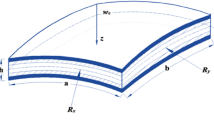Abstract
A new efficient meshless method based on the element-free Galerkin method is proposed to analyze the static deformation of thin and thick plate structures in this paper. Using the new 3D shell-like kinematics in analogy to the solid-shell concept of the finite element method, discretization is carried out by the nodes located on the upper and lower surfaces of the structures. The approximation of all unknown field variables is carried out by using the moving least squares (MLS) approximation scheme in the in-plane directions, while the linear interpolation is applied through the thickness direction. Thus, different boundary conditions are defined only using displacements and penalty method is used to enforce the essential boundary conditions. The constrained Galerkin weak form, which incorporates only displacement degrees of freedom (d.o.f.s), is derived. A modified 3D constitutive relationship is adopted in order to avoid or eliminate some self-locking effects. The numeric efficiency of the proposed meshless formulation is illustrated by the numeric examples.
Similar content being viewed by others
References
Reissner, E.: The effect of transverse shear deformation on the bending of elastic plates. Journal of Applied Mechanics 12, A69–A77 (1945)
Sze, K.Y., Yao, L.Q.: Modeling smart structures with segmented piezoelectric sensors and actuators. Journal of Sound and Vibration 235, 495–520 (2000)
Sze, K.Y., Lo, S.H., Yao, L.Q.: Hybrid-stress solid element for shell structures based upon a modified variational functional. International Journal for Numeric Methods in Engineering 53, 2617–2642 (2002)
Hein, P.: Diffuse element method applied to Kirchhoff plates. Department of Civil Engineering, Technical report, Northwestern University, Evanston, 11 (1993)
Krysl, P., Belytschko, T.: Analysis of thin plates by the element-free Galerkin method. Computational Mechanics 17, 26–35 (1995)
Krysl, P., Belytschko, T.: Analysis of thin shells by the element-free Galerkin method. International Journal of Solid and Structures 33, 3057–3080 (1996)
Garcia, O., Fancello, E.A., de Barcellos, C.S., et al.: Hp-Clouds in Mindlin’s thick plate model. International Journal for Numeric Methods in Engineering 47, 1381–1400 (2000)
Atluri, S.N., Zhu, T.: A new meshless local Petrov-Galerkin (MLPG) approach in computationalmechanics. Computational Mechanics 22, 117–127 (1998)
Atluri, S.N., Shen, S.: The meshless local Petrov-Galerkin (MLPG) method: A simple & lesscostly alternative to the finite element and boundary element methods. Computer Modeling in Engineering & Sciences 3, 11–51 (2002)
Atluri, S.N.: The Meshless Method (MLPG) for Domain and BIE Discretizations. Tech Science Press, USA (2004)
Noguch, H., Kawashima, T., Miyamura, T.: Element-free analysis of shell and spatial structures. International Journal for Numeric Methods in Engineering 47, 215–1240 (2000)
Kanok-Nukuchai, W., Barryl, W., Saran-Yasoontorn, K., et al.: On elimination of shear locking in the element-free Galerkin method. International Journal for Numeric Methods in Engineering 52, 705–725 (2001)
Dolbow, J., Belytschko, T.: Volumetric locking in the element free Galerkin method. International Journal for Numeric Methods in Engineering 46, 925–942 (1999)
Dolbow, J., Belytschko, T.: An introduction to programming the meshless element free Galerkin method. Archives of Computational Methods in Engineering 5, 207–241 (1998)
Hauptmann, R., Schweizerhof, K.: A systematic development of solid-shell element formulations for linear and non-linear analyses employing only displacement degrees of freedom. International Journal for Numeric Methods in Engineering 42, 49–69 (1981)
Reddy, J.N.: Mechanics of Laminated Composite Plates and Shells: Theory and Analysis, (2rd edn). CRC, Boca Raton (2004)
Yin, Y., Cao, Y., Yao, L.Q.: A new meshless method based on 2D-EFG for the analysis of piezoelectric laminated Timoshenko beam. SPAWDA 2011: In: Proceedings of the 2011 Symposium on Piezoelectricity, Acoustic Waves and Device Applications, Shenzhen, December 9–11 (2011)
Nayroles, B., Touzot, G., Villon, P.: Generalizing the finite element method: Diffuse approximation and diffuse elements. Computational Mechanics 10, 307–318 (1992)
Lancaster, P., Salkauskas, K.: Surfaces generated by moving least squares methods. Mathematics of Computation 37, 141–158 (1981)
Belytschko, T., Lu, Y.Y., Gu, L.: Element-free Galerkin methods. International Journal for Numeric Methods in Engineering 36, 229–56 (1994)
Liu, G.R., Gu, Y.T.: An Introduction to Meshfree Methods and Their Programming. Springer, Netherland (2005)
Timoshenko, S.P., Goodier, J.N.: Theory of Elasticity, (3rd edn). McGraw-Hill, New York (1970)
Li, Q., Soric, J., Jarak, T., et al.: A locking-free meshless local Petrov-Galerkin formulation for thick and thin plates. Journal of Computational Physics 208, 116–133 (2005)
Sze,, K.Y., Yao, L.Q., Pian, T.H.H.: An eighteen-node hybrid-stress solid-shell element for homogenous and laminated structures. Finite Elements in Analysis and Design 38, 353–374 (2002)
Qian, W.C., Ru, X.P.: A further study of the theory of elastic circular plates with non-Kirchhoff-Love assumptions. Applied Mathematics and Mechanics 16, 95–105 (1995)
Qian, W.C., Sheng, S.Z.: The first-order approximation of non-Kirchhoff-Love theory of elastic circular plate with fixed boundar under uniform surface loading (III)—numeric results. Applied Mathematics and Mechanics 18, 385–393 (1997)
McPherson, A., Ramberg, W., Levy, S.: Normal-pressure tests of circular plates with cahamped edges. Report No. 744, National Advisory Committee for Aeronautics (1942)
Srinivas, S., Rao, A.K.: Flexure of thick rectangular plates. Journal of Applied Mechanics 40, 298–299 (1973)
Senthilnathan, N.R.: A simple higher-order shear deformation plate theory. [Ph.D. Thesis]. The National University of Singapore, Singapore (1989)
Xu, Q.L.: New solution of rectangular plate with one edge built in subjected to uniform load. Journal of Zhengzhou Institute of Technology 17, 42–47 (1996)
Author information
Authors and Affiliations
Corresponding author
Additional information
The project was supported by the National Natural Science Foundation of China (11172192), the College Postgraduate Research and Innovation Project of Jiangsu province (CXZZ12 0803).
Rights and permissions
About this article
Cite this article
Yin, Y., Yao, LQ. & Cao, Y. A 3D shell-like approach using element-free Galerkin method for analysis of thin and thick plate structures. Acta Mech Sin 29, 85–98 (2013). https://doi.org/10.1007/s10409-012-0159-7
Received:
Revised:
Accepted:
Published:
Issue Date:
DOI: https://doi.org/10.1007/s10409-012-0159-7




